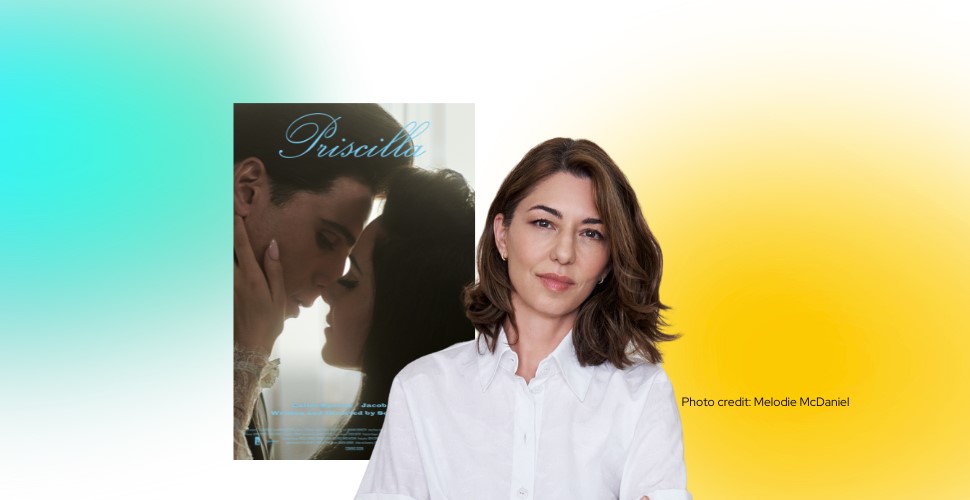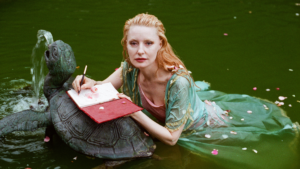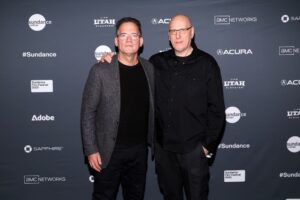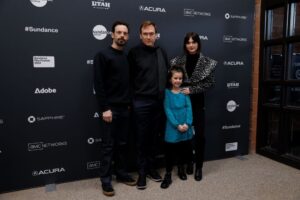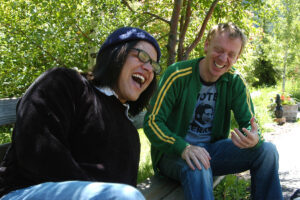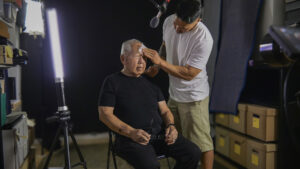By Stephanie Ornelas
Sundance Collab participants signed in from around the world to listen to Sofia Coppola (Lost in Translation, Marie-Antoinette) talk about her new film Priscilla.
Sundance audiences saw Coppola make her directorial debut with The Virgin Suicides at the Festival in 2000. Now, viewers are heading to theaters to see her highly anticipated biopic based on Priscilla Beaulieu Presley’s 1985 memoir Elvis and Me.
During Collab’s Spotlight Event: Sofia Coppola on Priscilla, Coppola walks participants through her filmmaking process, from balancing different themes to building the Graceland set from the ground up and staying true to Presley’s point of view. In addition to sharing some of her biggest takeaways before and during production, Coppola also looks back at some of the lessons she learned from her early projects and shares advice from her father, Francis Ford Coppola.
“My dad told me, ‘Know what your theme is. Be able to say the theme of your movie in one word. So, if anybody asks you, ‘Which shirt do you want her to wear? What cup do you want her to hold?’ Think about what the theme is. And [that] helps you make all these decisions because, as a director, you’re just making decisions all day long.”
Here are just a few takeaways from the online event:
The process of adapting
Coppola enjoys adapting works for her projects because filmmakers already have something to work with. It’s a puzzle that needs to be unlocked. “How do you translate the book into a visual medium? I enjoy that part.”
Looking back at when she made The Virgin Suicides, she explains how she wanted to be true to Jeffrey Eugenides’ book of the same name. It was the same for Priscilla, however Coppola also leaned into many personal conversations she had with Presley, even if those details weren’t in her memoir.
“If [Priscilla] told me something that wasn’t in the book, I could add that, and it would feel true. So, in a way, you can kind of gather information from outside a little bit more. [The film] has the research aspect of just learning about the time, looking at photos and their home movies, and looking for clues for insight.
“I’ve learned with adapting, you have to sometimes combine locations and combine characters,” Coppola continues. “Because I’ve been directing, I know [that] when we actually go to film, I have to be kind of practical. You can’t have too many different locations. But really, it’s like an editing process. I just try to go through the book and pick out my favorite moments that stick out, and then my goal is to capture the essence of her story. And you have to lose a lot of things. Which parts are the most important to tell the story that you want to tell?”
Then, Coppola will start to put images together and make a vision board. “I make [what] will eventually become a little book that I give the crew. And [I] just start to be immersed in the world and listen to music that feels related to that time.”
Balancing opposing themes
Priscilla explores themes like loneliness, teenage angst, and social status, but the film also says a lot with the unsaid. Coppola explains how she develops characters to convey their inner emotions and their journeys on screen.
“I always am interested in what people don’t say, and the spaces in between. A lot of times, you don’t say what you feel, and it comes out in some behavior. I love all those in-between moments, feeling that tension. I’m always interested when the characters are alone and what they do more than what’s said. I think about it when I’m writing because my scripts are pretty minimal. But usually, it’s more about the visuals of the moments.”
Coppola works to strike a balance between the darker and more problematic side of Elvis and the tender, lighthearted moments between him and Priscilla. Moderator Erica Elson, one of Sundance Collab’s digital course and event producers, was curious how she was able to establish that tone and stay true to it throughout the entire film.
“I really wanted to balance the dark and the fun of it. I cast Jacob because he’s so lovable and charming. And that’s how it sounded like Elvis was. I really wanted to show the rollercoaster of what her relationship sounded like,” emphasizes Coppola.
“It was Memphis in the ’60s. He expected her to stay at home and wait for him while the guys go out. There’s no thought about what she might need to be fulfilled. But I really tried to balance, and I really took it all from her book and her perspective.”
And exploring the creative struggles Elvis often dealt with was crucial, adds Coppola. “I thought [it] was important to understand where his frustrations are coming from, and just try to make them as human as possible without judging them. So I really tried to stay in her point-of-view [and] show the other characters as full characters.”
Creating an atmosphere for the cast and crew
Cultivating a safe environment for the cast and crew was essential to Coppola. Working with the actors is something that really motivates her.
“That’s the part I love. That’s so exciting after you’re alone for so long writing your script. You get to have actors come in and bring [the characters] to life,” she says. “I find it helpful to imagine the actors sometimes when I’m writing the script and how they would say it. And for [Priscilla], I could think of how Elvis talked and how they were. So that helped me imagine their tone.”
“So much of it is just casting the person [who] you feel has something that can convey what you’re looking for or has some essence of that character, and then [it’s about] letting them do their thing and giving feedback.”
Coppola always works to provide a secure and fun atmosphere for her crews, so they often played pickleball together during breaks and listened to music on set.
“I know how vulnerable it is to be on camera. I really think about that and want [the cast] to feel comfortable. I always try to keep it as intimate as I can with less people around. It’s stressful because you’re always running out of time, but it has to be fun, too. That’s how you do your best work.”
And Coppola absolutely leaves room for improvisation. The script is merely a starting point for her.
“I’m always open to what the actors’ input is and how they feel. It’s really not set in stone. I’m not precious about it. I don’t shotlist or figure stuff out before we’re on set.”
That was something she discovered when developing The Virgin Suicides, when the producers approached her asking where the shot list was.
“I learned [that] I don’t know until I see the actors in the space and what feels right for them. So, we rehearse [the scene] before we start shooting. And that’s when I work with my cinematographer to figure out the shots. It’s very collaborative.”
Rebuilding Graceland
There are a lot of references to Elvis’ residence: Graceland. Coppola shares how they built his living room based on the exact plans, but there were no photos of his bedroom. That was something the art department had to imagine.
“It was really fun. We shot up in Toronto, and we built all these sets. I’d never done that before. I worked on a stage where we built everything, and there was so much magic in walking on that set for the first time. We built our own Graceland in Toronto.”
“It was fun to have to invent your own version based on what we know about them,” she continues. “We had a great prop department, and it was fun to pick all [Priscilla’s] toiletries and have those shots, which is so much of the experience when you go somewhere new. To me, that’s so much about your identity. I just think all those details make the character feel real.”
At the end of the session, Sundance Collab participants had burning questions about everything from casting to working with Presley herself.
“I was really touched by her story, and I was just shocked. I didn’t know all these things about her. I had no idea that she was living at Graceland when she was in high school, going to school during the day and then staying up with Elvis at night. It just felt like she had this really whirlwind experience. I thought it was interesting that she seemed to go through so many things that all girls go through on their trip to womanhood.”
To hear more about Coppola’s journey to making Priscilla, including her approach to lighting and what it felt like showing Presley the final cut, check out the full recording of Spotlight Event: Sofia Coppola on Priscilla, which includes an exclusive Q&A.
Be sure to explore other Collab events, like the upcoming Spotlight Event: Alexander Payne on The Holdovers. And for updates on upcoming courses and discussions, sign up for Sundance Collab’s newsletter here.




